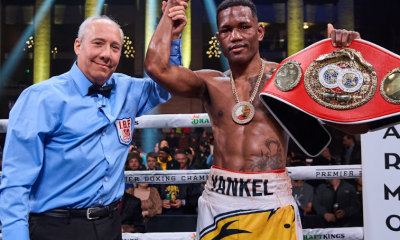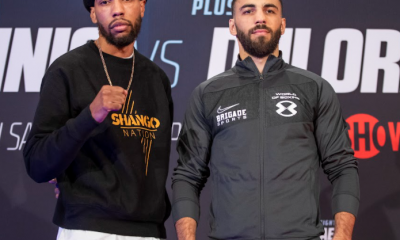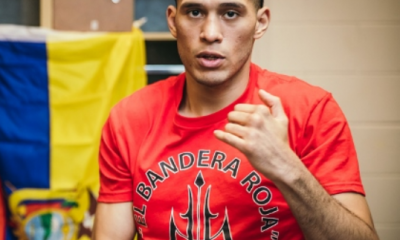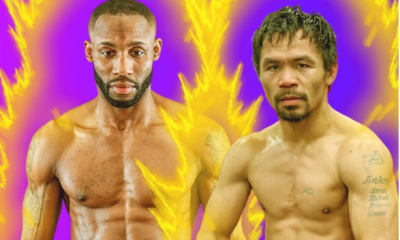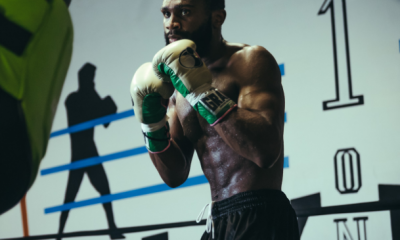Featured Articles
Rising Stars in Boxing: Episode 3
In the third installment of our new feature Rising Stars in Boxing, Kid Hersh and Matt Andrzejewski zero in on two young fighters at different stages of their evolving careers. One has a physique that evokes an image of the young Thomas Hearns and the other was tutored by Hearns’ legendary trainer, Emanuel Steward. Kid Hersh gets us started with a look at a rising contender from the Upper Midwest, Jamal James.
Rising Stars in Boxing: JAMAL JAMES
This coming Saturday, in Birmingham, Alabama, Jamal James (19-0, 9 KO’s) is taking a step up in class to fight tough veteran Wale Omotoso (26-2, 21 KO’s).
Wale, or “Lucky Boy” as he is aptly nicknamed, is one tough dude. He grew up in a street gang in Lagos, Nigeria, and was witness to many horrific acts of violence in the street. Beatings, shootings, and even murders (by machete no less) were something that he was observer to. Lucky to be alive, and even luckier to make it out of there, this piece of his life is what makes him a hard man in the ring. He has been a stiff test for notable fighters Jessie Vargas and Sammy Vasquez and he aims to upset the undefeated Jamal James, who hasn’t yet tasted power like his.
Jamal “Shango” James isn’t exactly new to the bright lights. Make no mistake, he can still be labelled as a prospect, but he is really looking for that coming out party. No better time to do it than for his twentieth victory and against a man like Omotoso.
It’s an excellent test for James because both Vargas and Vasquez were not without their problems in their respective showings against Omotoso. Vargas went down early and had to battle back from a deficit to eek out the decision while Vasquez had to deal with blood streaming down his face like an open faucet for the remaining rounds of his fight with Lucky Boy.
So what does Shango bring to the table? The obvious thing is size. Jamal is a whopping 6’2” welterweight that knows how to use his size. He is an excellent boxer from range as shown earlier this year in his fight against Javier Molina where he took the fight right out Molina as he coasted to an easy UD by boxing at distance and not allowing Molina to have any success past an occasional single shot landed.
In his other televised fight last September Jamal showed that same rangy boxing skill but also showed that he could overcome adversity against the tough and strong Juan Carlos Abreu. Abreu scored a knockdown in the fourth – although it should be noted that it was a tangle of feet to this writer’s eyes instead of a knockdown – but in any case it did fluster Jamal. Post knockdown it took him a few rounds to get his rhythm back as he seemingly couldn’t find the range and perhaps was a bit flustered. He would end up really coming on strong in the final rounds though, showing great stamina and getting his swagger back while controlling the outside beautifully.
Jamal’s stiff test this coming Saturday bodes well for him in the sense that outside, rangy boxing is exactly how you beat a powerful, slow plodder like Omotoso. What we will find out about Jamal is equally as interesting though. Can he take a punch from a real power puncher? Can he handle aggression like Omotoso is likely to bring for the entire fight?
This writer can’t wait to see the prospect tested for real. – KID HERSH
Rising Stars in Boxing: ERICK DE LEON
A former protégé of Emanuel Steward, Erick De Leon is slowly carving a name for himself as a top prospect in boxing. Fighting as a Super Featherweight, the 24 year old De Leon has amassed an early pro record of 13-0 with 7 knockouts fighting under the Top Rank banner.
De Leon was born in Mexico but relocated to Detroit as a kid. He would find his way to the legendary Kronk Gym where he worked with Steward. De Leon would go on to become an accomplished US amateur and earn victories in the unpaid ranks against name fighters such as Amir Imam, Julian Ramirez, Joel Diaz Jr. and Toka Kahn Clary.
Managed by Cameron Dunkin, De Leon has mostly fought the early portion of his career deep on Top Rank undercards and on small club shows against opponents who haven’t provided much of a threat. Dunkin is following the same blueprint in building De Leon that he used in building Terence Crawford. Dunkin is keeping De Leon active and putting him in with all types of different styles of fighters — the hope being that De Leon will gain valuable experience that pays dividends in the future.
The first thing that pops out when watching De Leon in action is his hand speed. And does it ever stand out. It is the type of speed that makes some in the sport think that De Leon could one day be very special.
De Leon can best be described as an aggressive southpaw. He comes forward and uses his feet to create angles to throw combinations with his blazing fast hands. Though not the hardest puncher, through improved technique his power has improved recently as well. After scoring just two knockout wins in his first six fights, De Leon has scored five knockout victories in his last seven appearances.
As with all prospects, there are questions surrounding De Leon. First, some wonder why Dunkin is taking it so slow with a fighter with a good amateur pedigree and whose skills appear obvious. The opponents so far have all been way overmatched and it seems like De Leon has been ready for some time to fight better opponents. Second, what will happen the first time De Leon faces adversity? He has not really been pushed in a fight so there is a big unknown as to what will happen the first time things are not going his way.
When analyzing prospects in boxing, there are those that just jump out when watching them fight for one reason or another. De Leon, to me, is one that jumps out primarily due to his hand speed. He has the make-up of a potential star and is getting better each time he steps in the ring. He is one to keep a close eye on as his career progresses. – MATT ANDRZEJEWSKI
Rising Stars in Boxing / foto: Jamal James, courtesy of The Premier Boxing Champions.
-

 Featured Articles4 weeks ago
Featured Articles4 weeks agoAvila Perspective, Chap. 330: Matchroom in New York plus the Latest on Canelo-Crawford
-

 Featured Articles3 weeks ago
Featured Articles3 weeks agoVito Mielnicki Jr Whitewashes Kamil Gardzielik Before the Home Folks in Newark
-

 Featured Articles22 hours ago
Featured Articles22 hours agoResults and Recaps from New York Where Taylor Edged Serrano Once Again
-

 Featured Articles4 weeks ago
Featured Articles4 weeks agoCatching Up with Clay Moyle Who Talks About His Massive Collection of Boxing Books
-

 Featured Articles5 days ago
Featured Articles5 days agoFrom a Sympathetic Figure to a Pariah: The Travails of Julio Cesar Chavez Jr
-

 Featured Articles3 weeks ago
Featured Articles3 weeks agoMore Medals for Hawaii’s Patricio Family at the USA Boxing Summer Festival
-

 Featured Articles1 week ago
Featured Articles1 week agoCatterall vs Eubank Ends Prematurely; Catterall Wins a Technical Decision
-

 Featured Articles4 weeks ago
Featured Articles4 weeks agoRichardson Hitchins Batters and Stops George Kambosos at Madison Square Garden

